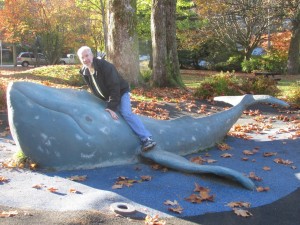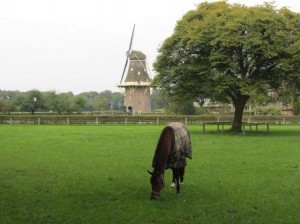I am away on sabbatical leave for the entire 2013-14 academic year, taking a break from teaching, advising, committee work and other college duties to focus on my research. At the end of August my family and I drove across the country, which was an adventure in itself (with stops at Yellowstone, Mount Rushmore, the Badlands and Grand Tetons, etc.). We are spending the fall in Vancouver, Canada, where I am a Visiting Professor of Zoology at the University of British Columbia. I love to teach, but after returning from my May Term Evolutionary Ecology field course in mainland Ecuador and the Galapagos Islands it has been nice to set coursework aside. Please note, however, that a sabbatical is not a vacation. I am enjoying a change of pace and change of surroundings, yet working hard to conduct and write up research in ways I seldom get at Hampden-Sydney. I am concentrating on my whale research but working on other projects as well, as I will explain.
I am enjoying lots of hikes under the huge trees of the coastal rain forest, but I have seen many marine mammals in the wild and in captivity, including humpback whales, killer whales, beluga whales, Pacific white-sided dolphins, Dall’s and harbor porpoises, Steller and California sea lions, harbor seals, and sea otters, not to mention loads of other cool wildlife, from eagles and other big birds to coyotes and giant slugs (which I have to watch out for as I run through the woods in the morning). It is beautiful here where the mountains meet the sea—or at least it is if you can see through the misty fog which often shrouds the shoreline.
My whale research currently focuses on the biomechanics and functional morphology of feeding in mysticete whales (like humpback and blue whales), and especially on the oral material, called baleen, which filters food from the water that flows into the mouth. Baleen is made of keratin, just like your hair and fingernails, and I am finding that although it is often described as a simple sieve, it is actually not at all a sieve but rather a highly dynamic filter whose porosity and other parameters varies according to flow conditions. In this respect I am working with engineers and physicists who study such things as cell filtration, hydrodynamics and hydraulics, and parachute deployment.
Last spring I was contacted by a Dutch engineer who asked me to join a collaborative project, inspired by a whale that washed up on the beach in the Netherlands, involving filtration in the humpback whale. The goal is to recreate the whale’s oral filter using 3D scanning and 3D printing—popular everywhere now, but especially in the Netherlands—so that engineers can design better filters and so we can better understand how whales catch prey and separate it from engulfed water.
This project involves biomimicry, which means creating industrial applications inspired by nature. Think of Velcro closures based on spiny burrs and other “sticky” plant seeds, or special racing swimsuits inspired by shark skin. Other examples include paint pigments based on iridescent scales of butterflies and super-sticky adhesives inspired by the glue on byssal threads that attach barnacles to rocks. Our biomimetic plan is to study whale filters, and in particular to create differently scaled 3D-printed models of varying pliancy, mimicking the way the whale’s oral filter really works.
Thus I spent two weeks of September dashing around Holland on trains, giving four lectures and a workshop while meeting with physicists, engineers, and industrial designers. One of the talks I gave was at a 3D printing conference at a polymer science park, where I felt out of place as the only biologist and non-Dutch speaker. I spent time at a shipyard in Delft, a natural history museum in Leiden, a model-making factory in Hengelo, and university campuses in and around Zwolle, mostly working with people from the Windesheim University of Applied Sciences. I had a little free time to explore the Dutch countryside but mostly worked with researchers and students. This is a project that is expected to continue for the next two or three years. I’ve picked up a bit of Dutch language, though the translation doesn’t always work well either way (see: http://www.windesheim.nl/over-windesheim/persberichten/2013/september/gastcollege-dr-alex-werth-over-evolutietheorie-en-darwin/).
I am traveling with my family to New Zealand to speak at a marine mammal conference in December. While in New Zealand I will spend time meeting with research colleagues and—ideally—seeing whales, dolphins, seals and sea lions, penguins, and other wildlife and scenic beauty in the North and South Islands. Fortunately, December is summer in the Southern Hemisphere.
In addition to my whale research I have been working hard to finish several publications on evolutionary biology, focusing especially on the evolution of form in organisms—or rather, why some forms seem not to evolve over long stretches of time. One such paper (with Professor Shear of the H-SC Biology Department) focuses on “living fossils” like horseshoe crabs and coelacanths. How and why do they stay the same? I wrote a second paper on vestigial features of evolution and development: leftover remnants of biological change reflecting earlier states. A third paper centers on the potential scientific and philosophical limits of evolutionary explanations, and a fourth paper, co-written with a historian/philosopher colleague from the University of Minnesota, looks at what we call the “naturalizing error.” Philosophers often speak of the “naturalistic fallacy” (that is, you can’t equate what you see in nature with how you ought to behave), but we’ve flipped the script and explain that people’s tendency to describe nature through the lens of personal preconception leads to biased analyses. For example, museum displays of Neanderthals typically present a “nuclear family” of parents and two children, which tells more about how we currently see ourselves than what likely occurred in the past.
That’s the short version of what I’ve been up to—I’m leaving out all the gory details—and I can continue to update folks on my sabbatical activities, especially my research studies and travels, with this blog. Meanwhile I hope everyone back at H-SC is enjoying a great year. We miss everyone!




